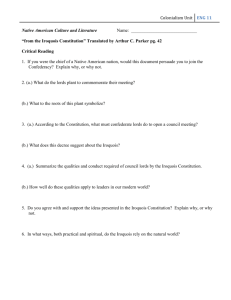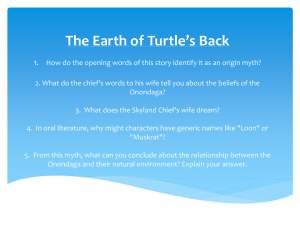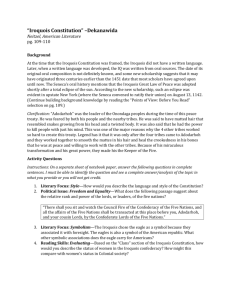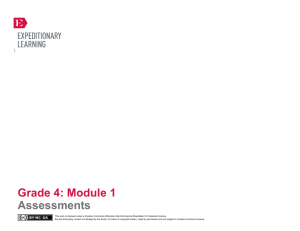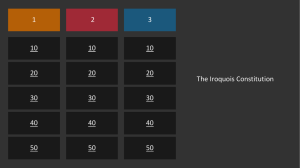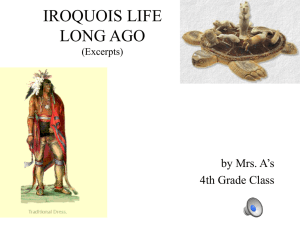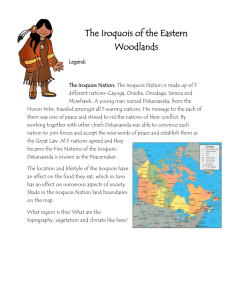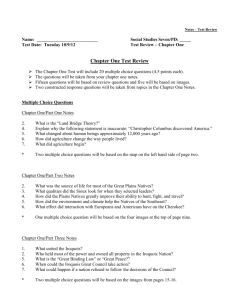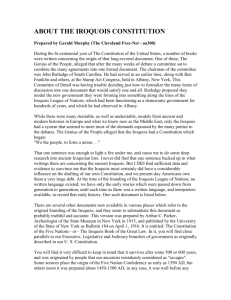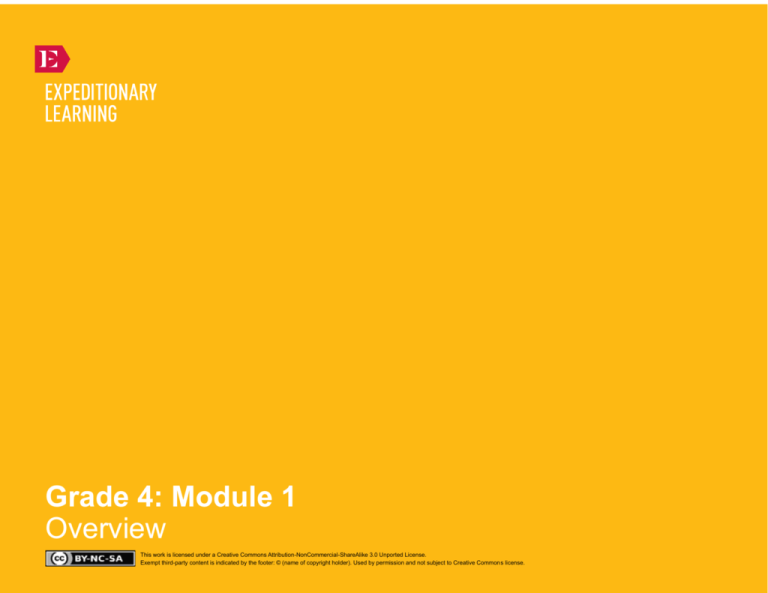
Grade 4: Module 1
Overview
This work is licensed under a Creative Commons Attribution-NonCommercial-ShareAlike 3.0 Unported License.
Exempt third-party content is indicated by the footer: © (name of copyright holder). Used by permission and not subject to Creative Commons license.
GRADE 4: MODULE 1: OVERVIEW
Becoming a Close Reader and Writing to Learn:
Native Americans in New York
This module supplements the Social Studies content many fourth-grade teachers
introduce at the start of the year. It ensures that students read, write, listen, and
speak to learn the history and contributions of Native Americans in New York State,
particularly the Iroquois Confederacy. Module 1 focuses on reading and listening to
primary and secondary sources to gather specific details and determine central
ideas, and to reinforce reading fluency and paragraph writing. Students will read
literature to develop an understanding of setting, characterization, theme, and
informational writing. In the first unit, students will read a recounting of the Native
American story of The Great Peacemaker, read short sections of the Iroquois
Constitution, or “Great Law of Peace,” and begin to focus on writing explanatory
paragraphs. In Unit 2, students read additional informational text about Native
Americans in New York with a focus on determining main ideas, and read and hear
an extended narrative text (Eagle Song by Joseph Bruchac, 840L) that reinforces
knowledge about the Iroquois culture and describes the importance of lessons from
that society in the lives of New Yorkers today. At the end of Unit 2, students draw
evidence from the literary text to support an analysis of the main character (W.4.9).
In Unit 3, students connect the past with the present by studying data designed to
help them think about places in their school where agreements like those found in
the Iroquois Constitution would benefit the school community. They then develop
their own constitution, drawing on their knowledge of the original Iroquois
Constitution, ideas from Eagle Song, and specific details from magazine articles
about conflict resolution. Then students independently write a paragraph in which
they explain to others how their constitution will resolve or prevent issues at school.
As a final on-demand assessment, students will revisit data and then write a
problem/solution style paragraph in which they explain how their constitution
could resolve or prevent issues at school.
Guiding Questions And Big Ideas
• How can our school community benefit from the beliefs and agreements of the Iroquois?
• Peace can be created and sustained through agreements and actions.
• Clear communication improves communities.
Performance Task
A Constitution for Our School Community
This performance task gives students a chance to apply their understanding about the beliefs and agreements made by the Iroquois people as evidenced in the Iroquois
Constitution, and explain how those beliefs and actions could benefit their school community. After reading texts regarding conflict resolution and data regarding school
bullying, students complete two tasks. First, they collaborate with their peers to design a constitution that can help support peace in their school community. Then
students independently write a paragraph in which they explain to others how their constitution will resolve or prevent issues at school. The two-part performance
task centers on NYSP12 ELA Standards W.4.2, W.4.5, W.4.9, and L.4.3.
© 2012 Expeditionary Learning, New York, NY. All Rights Reserved.
NYS Common Core ELA Curriculum • G4:M1: Overview • June 2013 •
1
GRADE 4: MODULE 1: OVERVIEW
Content Connections
• This module is designed to address English Language Arts standards. However, the module intentionally incorporates Social Studies content that may align to
additional teaching during other parts of the day. These intentional connections are described below.
NYS Social Studies Core Curriculum
• Native Americans—specifically the Iroquois (Haudenosaunee, People of the Longhouse) and the Algonquian—were early inhabitants of the New York region and state,
and contributed to the region’s history.
• Systems of government exist to create and enforce laws to protect people and communities.
• Native American groups developed political practices, including a consensus model, that influenced the development of the United States democracy.
© 2012 Expeditionary Learning, New York, NY. All Rights Reserved.
NYS Common Core ELA Curriculum • G4:M1: Overview • June 2013 •
2
GRADE 4: MODULE 1: OVERVIEW
English Language Arts Outcomes
NYSP12 CCLS Assessed in This Module: READING—LITERATURE
Long-Term Learning Targets
• RL.4.1. Refer to details and examples in a text when explaining what the text
says explicitly and when drawing inferences from the text.
• I can explain what a text says using specific details from the text.
• RL.4.2. Determine a theme of a story, drama, or poem from details in the text.
• I can determine the theme of a story or text.
• RL.4.3. Describe in depth a character, setting, or event in a story or drama,
drawing on specific details in the text (e.g., a character’s thoughts, words, or
actions).
• I can describe a story’s character or events using specific details from th e
text.
• RL.4.4. Determine the meaning of words and phrases as they are used in a
text.
• I can determine word meanings in a text.
NYSP12 CCLS Assessed in This Module: READING—Informational Text
Long-Term Learning Targets
• RI.4.1. Refer to details and examples in a text when explaining what the text says
explicitly and when drawing inferences from the text.
• I can use details and examples to explain explicit information and inferences in
informational text.
• RI.4.2. Determine the main idea of a text and explain how it is supported by key
details; summarize the text.
• I can determine the main idea using specific details from the text.
• RI.4.3. Explain events, procedures, ideas, or concepts in a historical, scientific,
or technical text, including what happened and why, based on specific
information in the text.
• I can explain the main points in a nonfiction text accurately.
• RI.4.4. Determine the meaning of general academic and domain-specific words
or phrases in a text relevant to a grade 4 topic or subject area.
• I can determine the meaning of academic words or phrases in an informational
text.
• I can make inferences using specific details from the text.
• I can summarize informational or persuasive text.
• I can support my explanation using specific details in the text.
• I can determine the meaning of content words or phrases in an informational
text.
© 2012 Expeditionary Learning, New York, NY. All Rights Reserved.
NYS Common Core ELA Curriculum • G4:M1: Overview • July 2013 •
3
GRADE 4: MODULE 1: OVERVIEW
English Language Arts Outcomes
NYSP12 CCLS Assessed in This Module: Informational Text
Long-Term Learning Targets
• RI.4.7. Interpret information presented visually, orally, or quantitatively (e.g., in
charts, graphs, diagrams, time lines, animations, or interactive elements on Web
pages).
• I can interpret information presented through charts, graphs, timelines, or
websites.
• RI.4.5. Describe the overall structure (e.g., chronology, comparison,
cause/effect, problem/solution) of events, ideas, concepts, or information in a
text or part of a text.
• I can describe the organizational structure in informational or persuasive text.
NYSP12 CCLS Assessed in This Module: Writing
Long-Term Learning Targets
W.4.2. Write informative/explanatory texts to examine a topic and convey ideas
and information clearly.
Introduce a topic clearly and group related information in paragraphs and
sections.
Develop the topic with facts, definitions, concrete details, quotations, or other
information and examples related to the topic.
Link ideas within categories of information using words and phrases (e.g., another,
for example, also, because).
Use precise language and domain-specific vocabulary to inform about or explain
the topic.
Provide a concluding statement or section related to the information or
explanation presented.
I can write an informative/explanatory text.
I can write an informative/explanatory text that has a clear topic.
I can group supporting facts together about a topic in an informative/explanatory
text.
I can develop the topic with facts, definitions, details, and quotations.
I can use linking words and phrases (e.g., another, for example, also, because) to
connect ideas within categories of information.
I can use contextually specific language/vocabulary to inform about or explain a
topic.
I can construct a concluding statement or section of an informative/explanatory
text.
• W.4.5. With guidance and support from peers and adults, develop and
strengthen writing as needed by planning, revising, and editing.
• I can use the writing process to produce clear and coherent writing (with
support).
© 2012 Expeditionary Learning, New York, NY. All Rights Reserved.
NYS Common Core ELA Curriculum • G4:M1: Overview • July 2013 •
4
GRADE 4: MODULE 1: OVERVIEW
English Language Arts Outcomes
NYSP12 CCLS Assessed in This Module: Writing
Long-Term Learning Targets
• W.4.9. Draw evidence from literary or informational texts to support analysis,
reflection, and research.
• I can choose evidence from fourth-grade literary or informational texts to
support analysis, reflection, and research.
• Apply grade 4 Reading standards to literature (e.g., “Describe in depth a
character, setting, or event in a story or drama, drawing on specific details in the
text [e.g., a character’s thoughts, words, or actions].”).
• I can describe in depth a character, setting, or event in a story or drama,
drawing on specific details in the text (e.g., a character’s thoughts, words, or
actions).
• Apply grade 4 Reading standards to informational texts (e.g., “Explain how an
author uses reasons and evidence to support particular points in a text.).
• I can explain how an author uses reasons and evidence to support particular
points in a text.
• W.4.10. Write routinely over extended time frames (time for research, reflection,
and revision) and shorter time frames (a single sitting or a day or two) for a
range of discipline-specific tasks, purposes, and audiences.
• I can write for a variety of reasons.
NYSP12 CCLS Assessed in This Module: SPEAKING AND LISTENING
Long-Term Learning Targets
• L.4.3. Use knowledge of language and its conventions when writing, speaking,
reading, or listening.
• I can express ideas using carefully chosen words.
• Choose words and phrases to convey ideas precisely.
• L.4.4. Determine or clarify the meaning of unknown and multiple-meaning
words and phrases based on grade 4 reading and content, choosing flexibly from
a range of strategies.
• Use context (e.g., definitions, examples, or restatements in text) as a clue to the
meaning of a word or phrase.
© 2012 Expeditionary Learning, New York, NY. All Rights Reserved.
• I can use a variety of strategies to determine the meaning of words and
phrases.
• I can use what the text says to help me to determine what a word or phrase
means.
NYS Common Core ELA Curriculum • G4:M1: Overview • July 2013 •
5
GRADE 4: MODULE 1: OVERVIEW
Central Texts
1. Selections from the Great Law of Peace, or Iroquois Constitution.
2. Cynthia O’Brien, “The (Really) Great Law of Peace,” in Kayak: Canada’s History Magazine for Kids (2010, Issue 33), 38–39.
3. Mary Englar, The Iroquois: The Six Nations Confederacy (Mankato, MN: Capstone Press, 2003); ISBN: 978-0-7368-4817-6.
4. Joseph Bruchac, Eagle Song (New York: Puffin Books, 1997); ISBN: 978-0-14-130169-3.
5. Marilyn Cram Donahue, “Smart-Speak: How to Say What You Mean,” in Current Health 1, December 2003, 12.
6. Clarisel Gonzalez, “Speaking Up,” in Scholastic News (Edition 5/6, 76:14), January 28, 2008, 6.
© 2012 Expeditionary Learning, New York, NY. All Rights Reserved.
NYS Common Core ELA Curriculum • G4:M1: Overview • July 2013 •
6
GRADE 4: MODULE 1: OVERVIEW
Calendared Curriculum Map:
Week at a Glance
Week
Instructional Focus
Long-Term Targets
Assessments
• Read “The (Really) Great Law of Peace”
• I can explain what a text says using specific
details from the text.
• Hearing and reading short selections from
the Iroquois Constitution
• I can explain the main points in a historical
text accurately.
• Mid-Unit 1 Assessment: Independent
reading about the Iroquois Confederacy; use
specific details to answer questions about the
text. (RI.4.1, RI.4.3, SL.4.1)
Unit 1: Haudenosaunee: The Great Peacemakers
Weeks 1-2
• Mystery Symbol: The Iroquois Flag
• I can effectively participate in discussion
with my peers and adults.
• Learn the structure of an explanatory
paragraph.
• Write explanatory paragraphs connecting
class flag to texts.
© 2012 Expeditionary Learning, New York, NY. All Rights Reserved.
• I can write an informative/explanatory text.
• End of Unit 1 Assessment: Write explanatory
paragraph about class flag and how it
connects to the texts they have read so far in
the module. (W.4.2 and SL.4.1)
NYS Common Core ELA Curriculum • G4:M1: Overview • July 2013 •
7
GRADE 4: MODULE 1: OVERVIEW
Calendared Curriculum Map:
Week at a Glance
Week
Instructional Focus
Long-Term Targets
Assessments
Unit 2: What Is Important to the Haudenosaunee (Iroquois People)?
Weeks 3-6
• Read The Iroquois: The Six Nations
Confederacy with a focus on central ideas,
supporting details, and context clues (1
week).
• I can determine the main idea using specific
details from the text.
• I can determine the meaning of academic
words or phrases in an informational text.
• Mid-Unit 2 Assessment: Independent
reading regarding Iroquois and answering
text-dependent questions. (RI.4.1, RI.4.2,
W.4.8, W.4.2, SL.4.1)
• Write explanatory paragraphs.
• I can write an informative/explanatory text.
•
• Read Eagle Song with a focus on setting,
character, and theme (2 weeks).
• I can describe a story’s setting using specific
details from text.
• End of Unit 2 Assessment: Students select
one scene from Eagle Song in which the
main character displays the beliefs of the
Great Peacemaker of the Iroquois and
explain how the character is upholding
traditional values, using details from the
informational texts and evidence from the
literary text. (RL.4.3, RL.4.11, W.4.9)
• I can describe a story’s character using
specific details from text.
• I can determine the theme of a story or text.
• I can effectively participate in a conversation
with my peers and adults.
© 2012 Expeditionary Learning, New York, NY. All Rights Reserved.
NYS Common Core ELA Curriculum • G4:M1: Overview • July 2013 •
8
GRADE 4: MODULE 1: OVERVIEW
Calendared Curriculum Map:
Week at a Glance
Week
Instructional Focus
Long-Term Targets
Assessments
• I can interpret information presented
through charts, graphs, timelines, or Web
sites.
• Mid-Unit 3 Assessment: Independent
reading of data and communication
strategies; answer questions using evidence
from the text, including questions about
main idea (RI.4.1 and RI.4.2)
Unit 3: A Constitution for Our School Community
Weeks 7-8
• Interpret data about bullying in schools,
connecting to key scenes in Eagle Song.
• Read informational articles about solutions
to bullying and conflict resolution in schools.
• I can answer questions using evidence from
the text.
• I can determine the main idea using specific
details from the text.
• I can effectively participate in discussions
with my peers and adults.
• Write a portion of a school constitution.
• I can write an informative/explanatory text.
• Write paragraphs to explain the constitution
to the school community.
• I can describe the organizational structure in
informational or persuasive text. (RI.4.5)
• I can use linking words and phrases to
connect ideas within categories of
information. (W.4. 2.c)
• I can use resource materials (glossaries,
dictionaries, thesauruses) to help me
determine the pronunciation and meaning of
key words and phrases.
• I can express my ideas using carefully chosen
words.
• End of Module Final Performance Task:
Students will collaborate to create sections of
a constitution, revising to create powerful
message. Independently, they will write a
paragraph to explain their constitution the
school community. (W.4.2, W.4.5, W.4.9,
L.4.3)
• End of Unit 3 On-Demand Assessment:
Students independently review the data they
examined earlier in the week, then explain
how their constitution with help prevent or
resolve issues. (W.4.2, W.4.10, SL.4.1)
• I can use the writing process to produce clear
and coherent writing.
• I can effectively participate in discussions
with my peers and adults.
© 2012 Expeditionary Learning, New York, NY. All Rights Reserved.
NYS Common Core ELA Curriculum • G4:M1: Overview • July 2013 •
9

